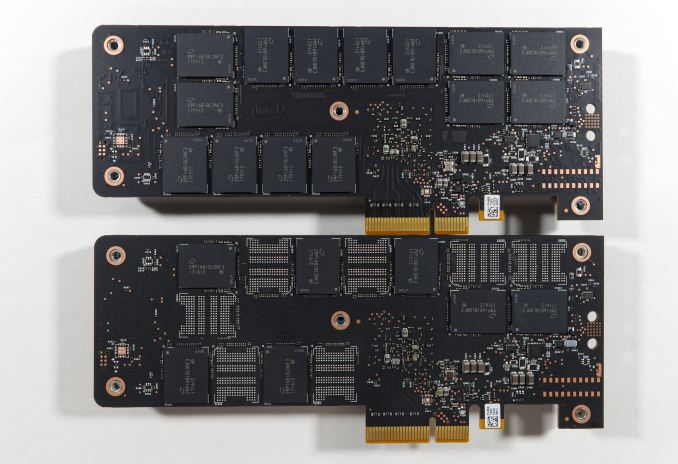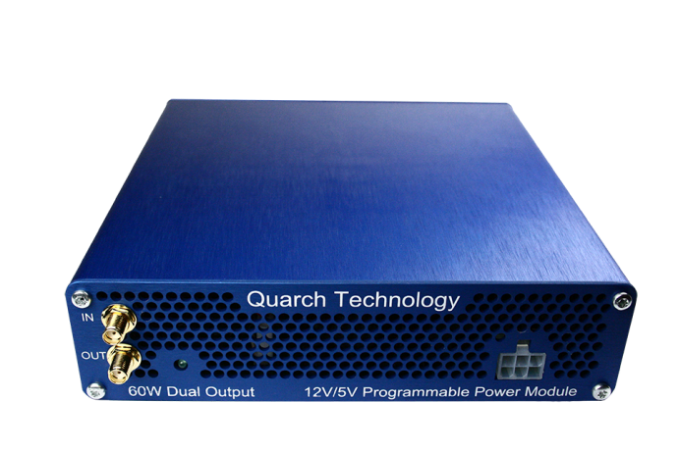The Intel Optane SSD 900p 480GB Review: Diving Deeper Into 3D XPoint
by Billy Tallis on December 15, 2017 12:15 PM EST
Our first look at the Intel Optane SSD 900p only included the smaller 280GB capacity. We now have added the 480GB model to our collection, and have started analyzing the power consumption of the fastest SSDs on the market.
This second look at the Optane SSD 900p doesn't change the overall picture much. As we speculated in our initial review, the design of the Optane SSD and its 3D XPoint memory means that performance does not scale with capacity the way most flash-based SSD designs do. The Optane SSD 900p uses a controller with seven channels for communicating with the 3D XPoint memory. The difference between the 280GB and 480GB models is merely a difference of three or five 3D XPoint dies per channel. Of the 28 memory package locations on the PCB, the 280GB model populates 21 with single die packages. The 480GB model uses all 28 spots, and half of the packages on the front are dual-die packages.
A single NAND flash die isn't enough to keep one of the controller's channels busy, because flash takes many microseconds to complete a read or write command, and even longer for erase commands. By contrast, 3D XPoint memory is fast enough that there is little to no performance to be gained from overlapping commands to multiple dies on a single channel. Increasing the number of dies per channel on an Optane SSD affects capacity and power consumption but not performance.
Intel recently let slip the existence of 960GB and 1.5TB versions of the 900p, through the disclosure of a product change notification about tweaks to the product labeling. The specifications for the larger capacities have not been confirmed but likely match the smaller models in every respect except power consumption. Since Intel has not officially announced the higher capacities yet, no MSRP or release date is available.
| Intel Optane SSD 900P Specifications | ||||
| Capacity | 280 GB | 480 GB | 960 GB | 1.5 TB |
| Controller | Intel SLL3D | |||
| Memory | Intel 128Gb 3D XPoint | |||
| Interface | PCIe 3.0 x4 | |||
| Form Factor | HHHL Add-in card or 2.5" 15mm U.2 |
HHHL Add-in card | HHHL Add-in card (U.2 unknown) |
|
| Sequential Read | 2500 MB/s | TBD | ||
| Sequential Write | 2000 MB/s | TBD | ||
| Random Read IOPS | 550k | TBD | ||
| Random Write IOPS | 500k | TBD | ||
| Power Consumption | 8W Read 13W Write 14W Burst 5W Idle |
<20.5 W | <24 W | |
| Write Endurance | 10 DWPD | TBD | ||
| Warranty | 5 years | TBD | ||
| Recommended Price | $389 ($1.39/GB) | $599 ($1.25/GB) | TBD | TBD |
Our SSD power measurement equipment burned out right before our first Optane SSD arrived. As of this week, we have newer and much better power measurement equipment on hand: a Quarch XLC Programmable Power Module. We'll explore its capabilities more in a future article. For now, we're filling in the missing power measurements from the past several reviews. Both of the Optane SSD 900p models have been re-tested with the Quarch power module on the entire test suite except for The Destroyer (so far). We haven't yet thoroughly validated the new power measurements against the results from our old meter so there may be some discrepancies, but the Optane SSDs draw so much power that any minor differences won't matter to this review. Everything that was tested with the old meter will eventually be re-tested on the Quarch power module, but we don't expect significant changes except to idle power measurements (where the Quarch power module should offer higher resolution).
Our first review of the Optane SSD 900p included a few puzzling results, most notably slightly higher performance when the ATSB Heavy and Light tests were run on a filled drive than when the Optane SSDs were freshly erased. One potential factor for this has since come to light: After first being powered on, Intel Optane SSDs perform a background data refresh process. This isn't necessary unless the SSD has been powered off for a long time, but the drive has no way to know how long it was without power. The documentation for the 750GB Optane SSD DC P4800X states this process can take up to three hours. We have not observed any clear transition in idle power during the first few hours after power-on, but there are occasional short periods where idle power drops by around 350-400mW (from around 3.5W).
Without a conclusive indication of whether background data refresh is happening and influencing benchmark results, we've re-tested the 280GB Optane SSD 900p for this review. Before running the synthetic benchmarks, the 900p was allowed to sit at idle for at least three hours. The ATSB tests were also conducted after an extended idle period, but the test system was rebooted between ATSB tests. Even with this precaution, there's still significant variability between test runs on the Optane SSD 900p and the full-drive performance is often better than freshly erased, so it appears there's another factor contributing to this behavior.
| AnandTech 2017 SSD Testbed | |
| CPU | Intel Xeon E3 1240 v5 |
| Motherboard | ASRock Fatal1ty E3V5 Performance Gaming/OC |
| Chipset | Intel C232 |
| Memory | 4x 8GB G.SKILL Ripjaws DDR4-2400 CL15 |
| Graphics | AMD Radeon HD 5450, 1920x1200@60Hz |
| Software | Windows 10 x64, version 1703 |
| Linux kernel version 4.12, fio version 2.21 | |
- Thanks to Intel for the Xeon E3 1240 v5 CPU
- Thanks to ASRock for the E3V5 Performance Gaming/OC
- Thanks to G.SKILL for the Ripjaws DDR4-2400 RAM
- Thanks to Corsair for the RM750 power supply, Carbide 200R case, and Hydro H60 CPU cooler
- Thanks to Quarch for the XLC Programmable Power Module and accessories












69 Comments
View All Comments
ddriver - Friday, December 15, 2017 - link
Which is MLC...Samsung realized nobody is catching up in the nand market and decided to push consumer, high end and mainstream enterprise a notch down to TLC.
So now that MLC is only a "high end enterprise" thing in their portfolio, they decided to pimp it up with a new moniker - z-nand. Alas, it is just good old MLC with a barely incremental controller. And claim that it has anything to do with SLC performance - which it does as much as an a race horse harness makes an old donkey faster.
They REALLY aren't trying.
mapesdhs - Monday, December 18, 2017 - link
Do you have a link to Intel's original PR articlea about this tech? Other people keep saying you're wrong, but if there is indeed a piece of Intel PR that at least implied an initial launch would provide the sort of speed gains you mention, then you absolutely have a point.jospoortvliet - Thursday, December 21, 2017 - link
I have no link, but as pointed out below, there is a fight with a strawman going on here. Intel certainly talked about 1000x improvement in latency of flash vs Optane - at that point they are talking about time it takes for a single flash cell vs an Optane cell. As Flash can only write to a block or more, it is far far slower, optane can address a single cell directly. And sure, that might very well be 1000x faster in theory - and even already in this very first Optane SSD.But, just like if you make one component (eg a piston) in a car engine 1000x faster the entire car won't drive 1000x faster - the other components also contribute to speed, as do external factors like, you know, wind, asphalt... So the car gets 10% faster as a whole. You see the same here: even if that one part is 1000x faster, flash controllers use a ram cache and splitting data over a dozen channels to overcome the inherent limitation of flash while the NVME protocol and PCIExpress puts limits at latency improvements, so the end result is that the Optane PCIE devices are occasionally >10x faster than SSD's but generally a factor 3-5.
Of course, if you put them in a DDR4 slot, they'll be unleashed a bit more and would beat a DDR4 SSD solution probably by a factor 30-50 in most cases with peaks of 100x. Still not 1000 and it'll never be...
So, in short, even if Intel is 100% correct and an individual cell responds 1000x faster, its response has to be mediated by the controller, go over a data bus etc etc. so you'll never measure it like that.
jospoortvliet - Thursday, December 21, 2017 - link
And of course Intel just screams '1000x faster response time' without very clearly identifying they're talking about a theoretical maximum. Well, it is marketing. You take the best looking numbers that are defensible and use them.eddman - Thursday, December 21, 2017 - link
No, intel claimed it for 3D xpoint, NOT optane. Xpoint is the name of the tech, optane is the storage devices based on the tech.Kidster3001 - Wednesday, January 3, 2018 - link
Intel never claimed Optane to be 1000x faster than anything. The 1000x faster was in reference to 3D-XPoint. XPoint = the memory cells; Optane = the SSD product line. Two completely different things.ddrіver - Saturday, December 16, 2017 - link
I'm not myself when I drink.farazgomot - Saturday, December 16, 2017 - link
I fully agree, why almost everybody is caustic to ddriver when he correctly is critic to only the marketing hype , not that the product is in any way bad ( except for the high price/ capacity)lmcd - Saturday, December 16, 2017 - link
He's arguing semantics when ridiculous performance claims are an industry norm. He's argued those semantics for 5 straight articles, and arguing with literally every comment he can find this very point. It's in the ballpark of 100 belligerent comments on 5 articles, which frankly is far closer to "caustic" than our collective treatment. It's fine if he states his opinion, but we're tired of being screamed at.Reflex - Saturday, December 16, 2017 - link
The problem with ddriver is that he is arguing against a strawman that was built up in his own mind. Optane was never promised to produce products that could deliver 1000x performance boosts in the first generation. PCM is itself as much as 1000x faster than traditional NAND for many operations while being orders of magnitude more durable.However the fact that you are using Optane/PCM does not in some way fix the fact that controllers aren't capable of that kind of performance yet, that PCIe bandwidth is way behind that level, that system memory, chipsets and CPU's couldn't keep up with that, that the software stack is not optimized for that, etc etc.
Intel delivered, mostly on time and for a cheaper price than is typical for a first gen of a new technology. Since they have previously stated what the performance capabilities of Optane/PCM are, the focus now will be on other aspects of the platform in order to enable that capability. This removes a major performance roadblock as they move towards an optical bus and optical chips, and ensures that system storage is not the long pole.
I'm fairly excited, its been ten years since any major change in storage has occurred and now it is finally here. And its reasonably priced for what it delivers from the get go.